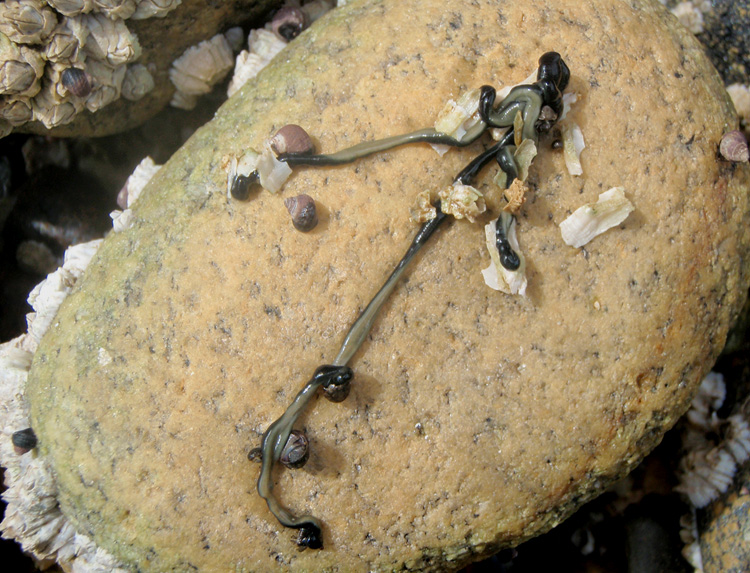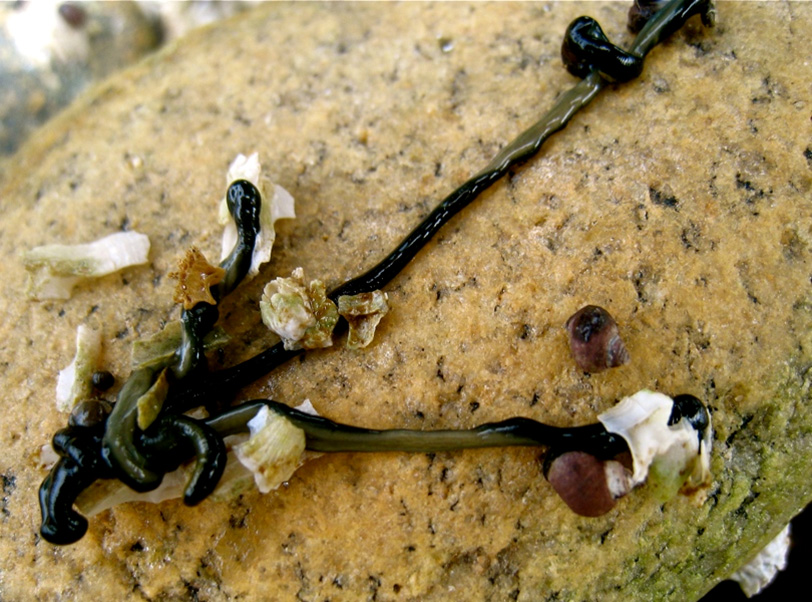Green ribbon worm, green nemertean worm, green and yellow ribbon worm • Emplectonema gracile
Identification
This thin worm is two toned: it has a dark green to yellow-green back and a white or pale yellow underside. The usual length for this worm is around 15 cm, though it occasionally gets longer (to 50 cm). Its anterior (head) end is paler. It may not be immediately recognizable as a worm, as one or more individuals often twist and knot themselves into knobbly masses. The green ribbon worm is unsegmented and as such belongs to Phylum Nemertea; click here to learn more about the Nemertines.
Habitat & Range
The green ribbon worm inhabits rocky areas around barnacles and mussel beds. It may be found twisted among kelp holdfasts or hiding beneath rocks. Its range extends from the Aleutian Islands to northern Mexico; it is also found along the coasts of Chile and Japan, as well as Atlantic and Mediterranean coastlines.
Similar Species
The purple-backed ribbon worm (Paranemertes peregrina) has a yellow underside and a dark purple back.
Intriguing Info
This worm preys on barnacles, particularly the acorn barnacle (Balanus glandula)
This thin worm is two toned: it has a dark green to yellow-green back and a white or pale yellow underside. The usual length for this worm is around 15 cm, though it occasionally gets longer (to 50 cm). Its anterior (head) end is paler. It may not be immediately recognizable as a worm, as one or more individuals often twist and knot themselves into knobbly masses. The green ribbon worm is unsegmented and as such belongs to Phylum Nemertea; click here to learn more about the Nemertines.
Habitat & Range
The green ribbon worm inhabits rocky areas around barnacles and mussel beds. It may be found twisted among kelp holdfasts or hiding beneath rocks. Its range extends from the Aleutian Islands to northern Mexico; it is also found along the coasts of Chile and Japan, as well as Atlantic and Mediterranean coastlines.
Similar Species
The purple-backed ribbon worm (Paranemertes peregrina) has a yellow underside and a dark purple back.
Intriguing Info
This worm preys on barnacles, particularly the acorn barnacle (Balanus glandula)
References
Adams, M.J. (2005). Emplectonema gracile (Green ribbon worm). Beach Watchers. Washington State University. Accessed 27/01/2015.
Harbo, R. M. (2011). Whelks to whales: Coastal marine life of the Pacific Northwest [revised]. Madeira Park, BC: Harbour Publishing. P. 80.
Lamb, A., and Hanby, B. (2005). Marine Life of the Pacific Northwest [electronic version]. Madeira Park, BC: Harbour Publishing.
Authors and editors of page
Kelly Fretwell and Brian Starzomski (2015).
Adams, M.J. (2005). Emplectonema gracile (Green ribbon worm). Beach Watchers. Washington State University. Accessed 27/01/2015.
Harbo, R. M. (2011). Whelks to whales: Coastal marine life of the Pacific Northwest [revised]. Madeira Park, BC: Harbour Publishing. P. 80.
Lamb, A., and Hanby, B. (2005). Marine Life of the Pacific Northwest [electronic version]. Madeira Park, BC: Harbour Publishing.
Authors and editors of page
Kelly Fretwell and Brian Starzomski (2015).





